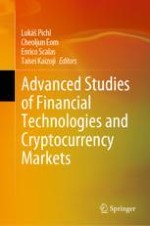2020 | OriginalPaper | Buchkapitel
The Optimal Foreign Exchange Futures Hedge on the Bitcoin Exchange Rate: An Application to the U.S. Dollar and the Euro
verfasst von : Zheng Nan, Taisei Kaizoji
Erschienen in: Advanced Studies of Financial Technologies and Cryptocurrency Markets
Verlag: Springer Singapore
Aktivieren Sie unsere intelligente Suche, um passende Fachinhalte oder Patente zu finden.
Wählen Sie Textabschnitte aus um mit Künstlicher Intelligenz passenden Patente zu finden. powered by
Markieren Sie Textabschnitte, um KI-gestützt weitere passende Inhalte zu finden. powered by
